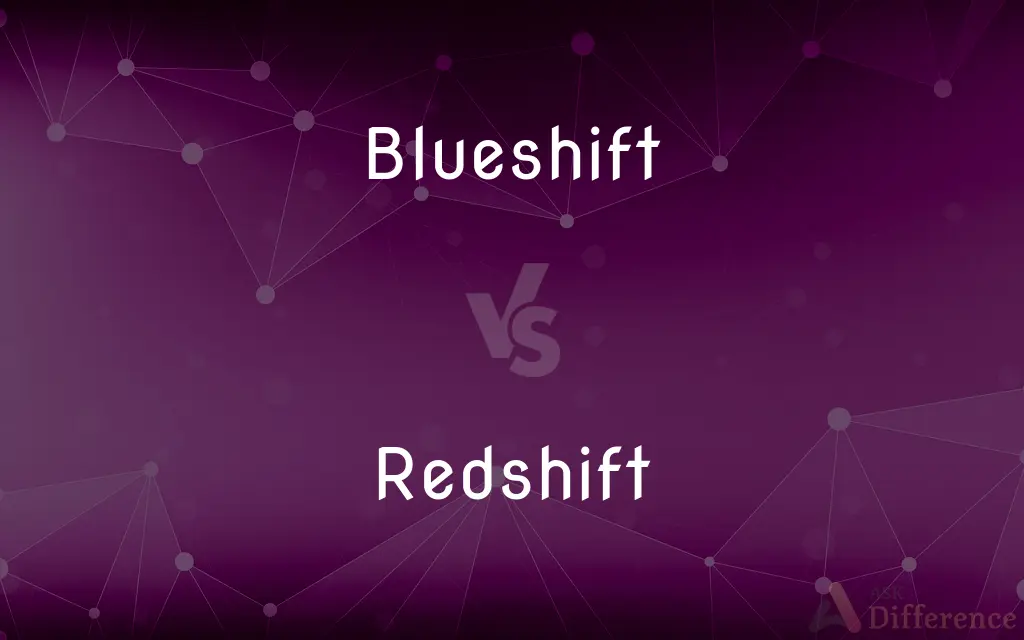Blueshift vs. Redshift — What's the Difference?
By Tayyaba Rehman & Urooj Arif — Updated on April 8, 2024
Blueshift indicates an object moving closer, showing a decrease in wavelength, while redshift suggests it's moving away, increasing wavelength.

Difference Between Blueshift and Redshift
Table of Contents
ADVERTISEMENT
Key Differences
Blueshift occurs when an astronomical object moves closer to an observer, resulting in a decrease in the wavelength of the light emitted by the object. This phenomenon is most often observed in astronomy, indicating the motion of stars or galaxies towards us. On the other hand, redshift happens when an astronomical object moves away from the observer, causing an increase in the wavelength of the light. This is also a common astronomical observation, used to deduce that the universe is expanding as distant galaxies move away from us.
In terms of visible light, a blueshifted object appears to move towards the blue end of the spectrum, which is associated with shorter wavelengths and higher energy levels. This shift can indicate not only the motion of an object but sometimes also the presence of strong gravitational fields affecting the light. Conversely, a redshifted object appears to move towards the red end of the spectrum, indicative of longer wavelengths and lower energy levels. This shift is key in understanding the velocity and direction of celestial bodies.
Blueshift is measured by the change in the frequency or wavelength of electromagnetic waves, including light, from a source moving towards an observer. It's a critical tool in astrophysics for studying the dynamics of our galaxy and others. Whereas redshift is measured to understand the universe's expansion, gauge distances to faraway galaxies, and explore the properties of the cosmic microwave background radiation.
Spectroscopy is a common method used to detect blueshift by observing the displacement of spectral lines towards shorter wavelengths. This technique allows astronomers to precisely measure how fast stars or galaxies are moving towards us. On the flip side, redshift is detected by observing the displacement of these lines towards longer wavelengths, offering insights into the rate at which the universe is expanding.
In non-astronomical contexts, blueshift and redshift principles apply to sound waves and other forms of waves, illustrating the Doppler effect. For instance, the sound of a siren from an approaching ambulance appears higher in pitch (blueshifted), while it lowers as it moves away (redshifted). This principle helps in various technological applications, including radar and sonar.
ADVERTISEMENT
Comparison Chart
Definition
Movement towards the observer
Movement away from the observer
Wavelength change
Decrease
Increase
Spectral shift
Towards blue
Towards red
Common cause
Gravitational attraction, motion
Expansion of the universe, motion
Measurement
Displacement of spectral lines to shorter wavelengths
Displacement of spectral lines to longer wavelengths
Compare with Definitions
Blueshift
Movement of an object towards the observer, indicated by a shift to shorter wavelengths.
The blueshift of a distant galaxy suggests it is moving rapidly towards the Milky Way.
Redshift
Uses spectroscopy to observe displacement of spectral lines towards the red end.
Redshift is measured in distant galaxies to determine their speed and direction away from us.
Blueshift
Appears blue due to the shift towards shorter wavelengths.
In astronomical observations, a star moving towards Earth might display a blueshift, making it appear bluer.
Redshift
Appears red due to the shift towards longer wavelengths.
A galaxy moving away from the Earth will exhibit a redshift, making it appear redder in color.
Blueshift
Utilizes spectroscopy to observe displacement of spectral lines towards the blue end.
Scientists detect blueshift in a star by measuring the displacement of its spectral lines.
Redshift
Demonstrates the Doppler effect with electromagnetic waves.
The redshift of light from a receding galaxy serves as an example of the Doppler effect in light.
Blueshift
Demonstrates the Doppler effect with light waves.
The blueshift in the light from an approaching star is a classic example of the Doppler effect.
Redshift
Movement of an object away from the observer, indicated by a shift to longer wavelengths.
The redshift observed in a distant galaxy is a key piece of evidence for the universe's expansion.
Blueshift
Applies to sound and other waves, indicating motion towards the observer.
The blueshift effect is similar to hearing a higher-pitched siren as an ambulance approaches.
Redshift
Applies to sound and other waves, indicating motion away from the observer.
A receding car's lower-pitched exhaust sound is an example of redshift in acoustics.
Blueshift
A blueshift is any decrease in wavelength (increase in energy), with a corresponding increase in frequency, of an electromagnetic wave. In visible light, this shifts a color towards the blue end of the spectrum.
Redshift
In physics, a redshift is an increase in the wavelength, and corresponding decrease in the frequency and photon energy, of electromagnetic radiation (such as light). The opposite change, a decrease in wavelength and simultaneous increase in frequency and energy, is known as a negative redshift, or blueshift.
Blueshift
(physics) A change in the wavelength of light, in which the wavelength is shorter than when it was emitted at the source.
Redshift
(physics) A change in the wavelength of light, in which the wavelength is longer than when it was emitted at the source.
Redshift
(US politics) The statistical bias towards Republican (or Blue Dog) candidates of US federal elections whose reported results vary considerably from those indicated by voter exit polls.
Common Curiosities
What does blueshift indicate in astronomy?
Blueshift indicates that a celestial body, like a star or galaxy, is moving towards the Earth.
What causes blueshift and redshift?
Blueshift is caused by objects moving towards the observer, decreasing the wavelength of light, while redshift results from objects moving away, increasing the wavelength.
Can blueshift and redshift apply to sounds?
Yes, both concepts apply to sound waves under the Doppler effect, where sound pitches change as sources move closer or farther away.
What does a spectral shift towards blue indicate?
A spectral shift towards blue indicates shorter wavelengths, suggesting an object is moving closer.
What is the role of gravity in blueshift?
Gravity can cause blueshift by pulling objects closer, thereby decreasing the wavelength of emitted light.
Do blueshift and redshift only apply to visible light?
No, they can apply to all electromagnetic waves, including radio, microwave, and X-rays.
Can we observe blueshift in our galaxy?
Yes, blueshift can be observed in stars or objects moving towards us within the Milky Way.
How does redshift affect the color of galaxies?
Redshift can make galaxies appear redder as their light shifts to longer wavelengths.
How are blueshift and redshift measured?
Both are measured using spectroscopy, by observing the displacement of spectral lines towards the blue or red end of the spectrum.
Why is redshift important in cosmology?
Redshift helps determine the universe's expansion rate and the distance to faraway galaxies.
How does redshift support the Big Bang theory?
Redshift supports the Big Bang theory by evidencing the universe's continuous expansion.
Is blueshift common in the universe?
Blueshift is less common than redshift, as most galaxies are moving away from us due to the universe's expansion.
Can the Doppler effect explain all redshifts and blueshifts?
The Doppler effect explains redshift and blueshift due to motion, but not those caused by the expansion of space or gravitational effects.
Share Your Discovery

Previous Comparison
Unmemorable vs. Immemorable
Next Comparison
Unliveable vs. UnlivableAuthor Spotlight
Written by
Tayyaba RehmanTayyaba Rehman is a distinguished writer, currently serving as a primary contributor to askdifference.com. As a researcher in semantics and etymology, Tayyaba's passion for the complexity of languages and their distinctions has found a perfect home on the platform. Tayyaba delves into the intricacies of language, distinguishing between commonly confused words and phrases, thereby providing clarity for readers worldwide.
Co-written by
Urooj ArifUrooj is a skilled content writer at Ask Difference, known for her exceptional ability to simplify complex topics into engaging and informative content. With a passion for research and a flair for clear, concise writing, she consistently delivers articles that resonate with our diverse audience.














































